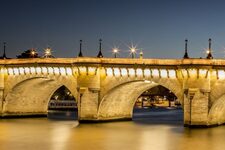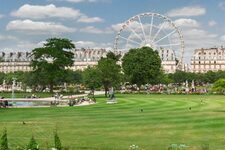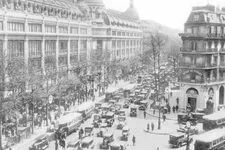Stroll along the Seine

To help you on your journey, start by downloading the map below:
Estimated duration of the route: 2h30
Estimated distance of the route: 4km
1 - Meeting in front of the Clock Tower, at 2 Boulevard du Palais
The Clock Tower was built between 1350 and 1353 on what was once a marshy land, at the request of King John II the Good. Framed by two allegorical figures representing Law and Justice, it was once a watchtower that served the security of the Palace.
Witness to the greatest events in the History of France, the Conciergerie – also called the Palace of the City – was the seat of power for the kings of France since the 10th century, and then served as a royal residence until the 14th century. Along the quay of the Clock, the palace was once larger and extended to the current Palace of Justice of Paris. It was during the French Revolution that the place became the sad symbol of the violence perpetrated during this period: revolutionary prisons were established there and Queen Marie Antoinette, among others, was imprisoned there before her public execution. An antechamber of death during the Terror, the prison of the Conciergerie let few prisoners go free. It occupied the ground floor of the building and the two towers. The upper floor was reserved for the Parliament. Exciting, the visit to the Conciergerie is a must for history enthusiasts.
2 - Continue along the Seine on the Quai de l’Horloge and turn left at the end of the quay to cross the Pont Neuf
Built in the early 17th century, the Pont Neuf is the oldest of the Parisian bridges. Adorned with its 381 grimacing faces, equipped with sidewalks to protect pedestrians from mud and horses, and devoid of any housing and commerce, this bridge was a great novelty at the time and has retained the name that was spontaneously given to it back then. Moreover, it is the first stone bridge in Paris to completely cross the Seine and to be uncovered. By crossing the bridge, you move away from the Ile de la Cité to pass to the other side of the river, on the left bank of Paris.
3 - Along the Quai de Conti. At number 23, discover the Mazarine Library and the Institute of France
The oldest public library in France, the Mazarine Library originates from the personal library of Cardinal Mazarin (17th century). In 1643, Mazarin commissioned Gabriel Naudé, a French scholar and librarian, to establish a reference library in Paris. Naudé complied and enriched it by purchasing collections, both in France and neighboring countries. By 1648, the library contained approximately 40,000 volumes, making it the most important collection assembled in Europe up to that time. The period of serious troubles and popular revolts that struck France between 1648 and 1653 marked a halt in the development of the institution. The Parliament of Paris decided to confiscate all of Mazarin's property. In December 1651, the Parliament placed a bounty on his head and decided to sell everything contained in the Mazarin Palace, starting with the library. It was therefore dispersed on January 8, 1652. Naudé managed to save a small portion of the works, with the idea of one day being able to reconstitute it. Upon his return to Paris, Mazarin took care of it with the help of a former collaborator. The works saved by Naudé were recovered, and in 1661, the second library regained almost the importance of the first. Today, the Mazarine Library is under the administrative authority of the Institute of France, located at number 23 Quai Conti.
4 - Cross the Seine to the right bank to take the Pont des Arts
In the early 19th century, Napoleon Bonaparte requested the construction of a footbridge connecting the two banks of the Seine. Reserved for pedestrians and featuring nine cast-iron arches, it was the first metal footbridge in Paris. Closed to traffic in 1977, it collapsed two years later after a collision with a boat. In 1980, the bridge was dismantled to be reassembled ten years later at the same location and now attracts tourists from all over the world.
At various times a place for exhibitions and inspiration for painters and photographers, for romantic encounters and picnics among friends during the summer, the Pont des Arts is unlike any other in Paris. Its uniqueness came from its gridded balustrades completely covered in "love locks" hung here by couples from around the world. For the preservation of the bridge, these locks were removed in 2015.
5 - Upon leaving the bridge, you arrive at the Tuileries quay from which you can see the walls of the Louvre
With an area of over 135,000 m², the Louvre Palace is the largest palace in Europe. Spanning over 800 years, the construction of the Louvre almost single-handedly traces the history of the capital. With 210,000 m² of space, of which 60,600 m² is dedicated to exhibitions, the Louvre Museum is now one of the largest museums in the world. Holding a very diverse and extremely famous collection of artistic pieces, such as the Venus de Milo and Mona Lisa, the Louvre is the most visited museum in the world.
6 - Head left along the Tuileries quay, and once you reach the Tuileries Garden, cross it in the middle
The Tuileries Garden gets its name from the fact that its location was previously occupied by tile factories. Covering an area of 25 hectares, the place is now home to the largest French-style garden in the city. It once surrounded the now-destroyed Tuileries Palace, which was the king's residence. From the Carrousel Square, the Tuileries Garden stretches nearly a kilometer long to the Place de la Concorde, between Rue de Rivoli and Tuileries quay. In the summer, part of the park remains open all night, and many picnickers and seasoned walkers take advantage of it to stay late into the night. If you want to have a quick lunch with friends, the garden has several small sandwich stands available. Note that during the months of July and August, the Tuileries Garden hosts a traditional family fair, the "Tuileries Fair."
7 - Exiting the garden, you come across the Place de la Concorde
At the initiative of Louis XV, the Place de la Concorde was created between 1755 and 1775. In 1839, King Louis Philippe wished to redesign the square and ordered the construction of two magnificent fountains and statues representing the eight largest cities in France at the time: Bordeaux, Brest, Lille, Lyon, Marseille, Nantes, Rouen, and Strasbourg. Rostral columns were also installed there, as well as an obelisk that was once erected in front of the Temple of Luxor and offered by the Viceroy of Egypt, Méhémet Ali, to King Charles X as a sign of goodwill. The Place de la Concorde overlooks the banks of the Seine but is closed on its northern side by the Hôtel de la Marine, the Hôtel Crillon, the Madeleine Church, and the Palais Bourbon.
8 - Take now the Avenue des Champs-Elysées
The Champs-Elysées derive their mystical name from the place in Hell where pure souls resided, in Greek mythology. Among the main tourist attractions of the city, the avenue stretches nearly 2 km, from the Place de la Concorde to the Place Charles-de-Gaulle. In its lower part, to the east of the Champs-Elysées-Marcel-Dassault roundabout, the avenue transforms into the "Promenade des Champs-Élysées," which runs alongside the garden of the avenue for 700 meters. Surprisingly, the garden has not changed since 1840 and offers lovely surprises to walkers. Statues, fountains, and music kiosks sit alongside the magnificent museums of the Grand Palais, Petit Palais, and the Palais de la Découverte, the performance halls for children, and the restaurants where great names of French cuisine have worked. The trees and flowerbeds provide beautiful walks throughout the year.
Also discover our selection of the best romantic places in Paris and dinner cruises on the Seine.


































